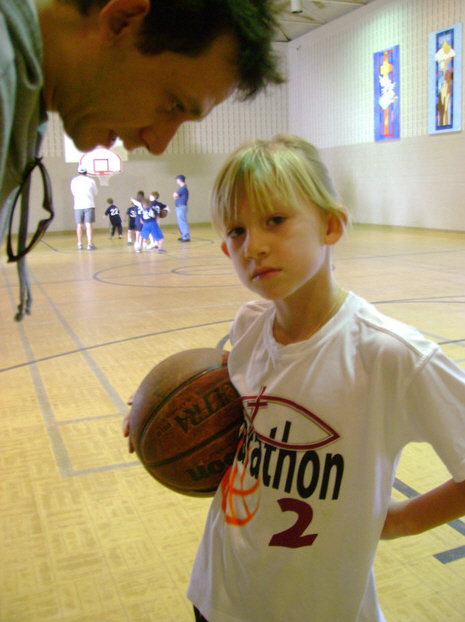 Brian Grasso of the International Youth Conditioning Association (IYCA) wrote an interesting article where he gets into an important question of whether we are training, teaching or coaching our young athletes.
Brian Grasso of the International Youth Conditioning Association (IYCA) wrote an interesting article where he gets into an important question of whether we are training, teaching or coaching our young athletes.
Grasso is not a basketball coach. Instead, his area of expertise is around youth athletic development. That is, age and stage appropriate physical development for young athletes. In his world, he is quite well known. I was drawn to him quite some time ago because I support the notion that adult paradigms of physical development should not be unilaterally applied to kids. Also, he’s an information sharer. I love it as new ideas abound.
A couple things jumped out to me in this blog. For starters, he challenges what he sees athletic trainers doing with young athletes around testing. Grasso argues that incorrect assessments are being used.
Markers for improvement – especially in the young athlete – should allow “…the trainer to observe and record the technical ability of a young athlete during specific exercises.”
Right now, the trend is for a trainer to put kids through a battery of pre- and post-training cycle tests to demonstrate that their training regiment ‘improved’ the athlete’s performance. As Grasso points out, those tests and assessments are focused on the basic elements of speed, strength and flexibility.
“Young athletes, as are their parents, become mentally conditioned to ‘buy into’ a given trainer or facilities training program when they see improvements being made… Even in the pre-adolescent years!”
What those athletes and parents fail to realize is that any detrained individual, regardless of age, will show improvements pre- and post-training. These test scores do not necessarily reflect athletic development or the improvement that will lead to sustained or sustainable performance gains.
What’s more integral to long term athlete development are the form and function within which that individual moves into or out of an athletic position or movement sequence.
Incorrect Assessments
A yellow or red flag should pop up in your mind if you have an athlete or team working with a trainer who puts the athlete(s) in a weight room without assessing for any movement dysfunction.
Building strength on top of dysfunction is a major problem that our athletes and coaches fall prey to.
Grasso: “What should become the goal of every trainer, coach, parent and young athlete is to learn and systematically improve on his or her skill levels … In that, I hold firm to the notion that markers for improvement should be monitored by using a system that allows the trainer to observe and record the technical ability of a young athlete during specific exercises.
Rate Of Technical Ability
There are tools available out there to help with technical assessment. Functional Movement Screens (FMS) is an effective means that many athletic trainers and coaches can use.
Grasso suggests creating a “Rate of Technical Ability” (RTA).
Develop a 1–5 scale that has technical performance markers evident at each ascending score. In a squat for instance, an RTA scale may look like this:
- 1 = Knees are valgus (inward)/lumbar spine is either rounded or arched/head is down/weight is on toes or ball of foot
- 2 = knees are valgus/lumbar spine is either rounded or arched/head is down
- 3 = lumbar spine is either rounded or arched/head is down
- 4 = lumbar spine is either rounded or arched
- 5 = Perfect form
Start with body weight squats and teach proper form and execution. Grade your young athletes on a piece of paper as to where they are on your ‘5’-point scale. Progress in volume or load only when they have reached a ‘5’. This lays the foundation for future developed skill and allows for a safe progression.
Building A Competency-Based Models Of Skill Development
To me, the framework that Grasso has outlined, can be applied to basketball specific skill development. And, the core principle applies: adult paradigms of skill development should not be unilaterally applied to kids.
You see, I do quite a bit of talent identification (scouting) and in the process of obtaining feedback (assessments) from other basketball coaches, the commentary is so arbitrary. As a result, with the help of a few other development coaches, I created the following assessment measure (pictured) for Canada Basketball’s Centre for Performance:
 The rationale for creating this assessment too was to:
The rationale for creating this assessment too was to:
- create a common language for athlete assessment
- move toward discussions of demonstrated competencies by the athlete
- implement a tool whereby an athlete could understand, more specifically, how their skills were being evaluated
- allow for athletes, in a training setting, to be separated based on competencies versus age (or, other arbitrary measures)
Until reading Grasso’s blog, I obviously wouldn’t have articulated it as a RTA. But, in a way it is just that.
Hey… I’m throwing it out to everyone in theLLaBB-oratory… Come up with a version for each skill that you deem pertinent to skill development and assessment (e.g. ball handling & penetration, passing, defense, footwork, etc.). Refine and experiment with the concept. And, share it with others.
Comment below with your thoughts and share new ideas that you come up with.
/sef.